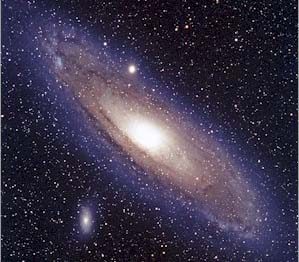2007 Gamma ray burst did not originate from neutron stars or black holes in Andromeda Galaxy
 Washington, Jan 5: New observations from physicists have led to the conclusion that intense burst of gamma rays possibly coming from the Andromeda Galaxy in February 2007 lacked a gravitational wave, which rules out an initial interpretation that the burst came from merging neutron stars or black holes within the galaxy.
Washington, Jan 5: New observations from physicists have led to the conclusion that intense burst of gamma rays possibly coming from the Andromeda Galaxy in February 2007 lacked a gravitational wave, which rules out an initial interpretation that the burst came from merging neutron stars or black holes within the galaxy.
Gamma ray bursts are among the most violent and energetic events in the universe.
On Feb. 1, 2007, four gamma ray satellites measured a short but intense outburst of energetic gamma rays originating in the direction of the Andromeda galaxy 2.5 million light years from Earth.
The majority of short (less than 2 seconds) gamma ray bursts (GRBs) are thought to come from the merger and coalescence of two massive but compact objects such as neutron stars or black hole systems. They also can come from less-common soft, gamma ray repeaters, which emit fewer intense gamma rays.
The most likely explanation for the burst of gamma rays was initially considered to be the merger of two neutron stars or black holes. Such a monumental cosmic event occurring in a nearby galaxy should have generated gravitational waves that would be easily measured by the ultra-sensitive LIGO (Laser Interferometer Gravitational-Wave Observatory) detectors.
But, the absence of a gravitational wave signal meant the burst could not have originated in this way in the Andromeda Galaxy.
But during February's blast of gamma rays, the four-kilometer and two-kilometer gravitational wave interferometers at LIGO's Hanford facility, Washington, were collecting data, but did not detect any associated gravitational waves.
A revised interpretation, presented last month by Isabel Leonor from the University of Oregon (UO), suggests two possible origins: A merger event beyond Andromeda or a burst from an astronomical object known as a soft gamma-ray repeater within Andromeda. The latter, also called a magnetar, involves neutron stars with enormous magnetic fields that occasionally produce big outbursts of gamma rays.
"In general, our understanding of GRBs and soft gamma ray repeaters has increased dramatically in the past decade but is still in an early stage," said Ray Frey, a professor of physics from UO. "So every piece of the puzzle that is put in place gives the overall picture more clarity," he added. (ANI)